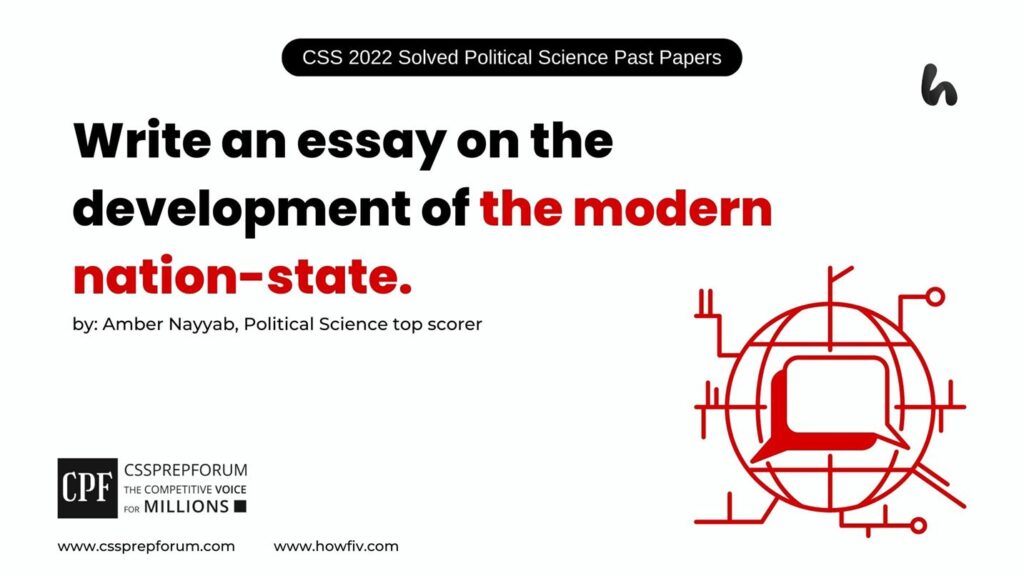CSS Solved Political Science Past Paper 2022 | Write an essay on the development of the modern nation-state.
The following question is attempted on the same pattern, taught by Sir to his students, scoring the highest marks in compulsory subjects for years. This solved past paper question is uploaded to help aspirants understand how to crack a topic or question, how to write relevantly, what coherence is, and how to include and connect ideas, opinions, and suggestions to score the maximum

Question Breakdown
In this question, the examiner demands a thorough analysis of the development of the modern nation-state, its history, the signing of the Treaty of Westphalia 1648, the journey from monarchy to democracy and liberalism, its critique in the modern world with ultra-nationalistic themes in the globalized world.
Outline
1- Introduction
2- Defining the Modern nation-state and its components
3- Historical analysis; Pax Romania to European Feudalism to Treaty of Westphalia 1648
4- Colonial pursuit of Europe; degrading the articles of Westphalia
5- A journey towards globalized liberalism; post WW2 scenario and “End of History”
6- Critique of a modern nation-state; Ultra-nationalism, realpolitik, and nuclear proliferation
7- Conclusion

Answer to the Question
Introduction
According to anthropologist Ernest Renan, all the European States were originally formed under the influence of a specified race and dynasty. Starting from Sardinia Dynasty in Italy to Germanics and Slavs in Germany, all shaped the definition of a ‘Nation’ according to their vested interests as Adolf Hitler obsessively did with Jews due to his obsession with the Aryan race during World War 2. Ibn-e-Khaldun’s concept of ‘Assabiyah’ showcases assimilation, nation-building, and vigilance to avert a kleptocratic government. But European dynastic and tyrant monarchs took race as a deciding factor in running a state and entered into the realms of corruption, narcissism, and nepotism. During this chaos, states transitioned towards feudalism, but the modern nation-state was still a dream. It took various steps, the period of renaissance and enlightenment to separate the Church from the Political government. As Niccolò Machiavelli aptly remarked, there is no place for morality in politics and the Church is just a state institution. The voyage of the modern nation-state is steered by the storms of imperialism and the notion of divine kingship.
Defining Modern nation-state and its components
A modern nation-state is defined as “a territorial bounded sovereign polity ruled in the name of a community of citizens who identify as a nation”.
According to the charters and articles of the Treaty of Westphalia 1648, the following are the components of a modern nation-state:
- ✓ The population is the first determinant of a modern nation-state. It could vary from state to state, as countries like Switzerland and India vary in the size of their population but still be called modern nation-states.
- ✓ A fixed territory with legitimate Internationally recognized boundaries, is considered another yet equally important component of a modern nation-state. There can be smaller territorial states like Bhutan and larger area-holding states like China.
- ✓ A government working under the border premises of a state, ruling its citizens would be considered the third determinant of a modern nation-state. The type of government is not specified as it can vary from state to state and depends upon the social and political culture of that very state. The Russian communist government and the U.S. capitalistic government are two types. The following are three essentials of a government:
- The judiciary
- The legislature
- The executive
- ✓ Last but not least, sovereignty is a final determinant of a modern nation-state. According to Clifford Geertz’s translation of Sydney W. Mintz’s lecture on the topic “what is a state if it’s not a sovereign?” sovereignty is the driving factor of a state otherwise, the state becomes a failed state under the influence of either colonial powers or hegemonic international states. This contemplates the need for sovereignty for a modern nation-state.
Historical analysis; Pax Romania to European Feudalism to Treaty of Westphalia 1648
The early holy Roman empire grew to get a ‘Pax Romania’ but after the fall of Romans in 1453, that dream couldn’t succeed. Christianity grew eventually, but that created a rift between states on the grounds of Martin Luther’s beliefs and Calvinism. In addition to the powers of Popes, feudalism sprouted. This diaspora further deepened the religious extremity and states waged wars against each other. The famous 30 years war shook the European states militarily, economically, and politically. It was at that point, Europeans joined their heads together at Osnabruck and Muster to devise the “Peace of Westphalia” in 1648. According to this, the state of war ended in Europe after 30 long years and various key points were agreed upon by the involved stakeholders to maintain peace and order. It included respecting each other’s territoriality, sovereignty and autonomy. Furthermore, diplomacy was introduced and international law and positivism were ushered in, creating concepts of a ‘Balance of Power’. Hence, today’s modern nationalism and nation-states are aligned on the contours of the Treaty of Westphalia 1648.
Colonial pursuit of Europe; degrading the articles of Westphalia
Although the Treaty of Westphalia drew territorial lines between nations and introduced diplomatic channels and concepts like the balance of power, it didn’t take much longer for the European dynastic powers to degrade the articles of the treaty. First of all, the legacy of bloodshed was initiated during the ‘Reign of Terror’ and its aftermath. The French revolution of 1789, and its practical manifestation in the rest of Europe created a series of revolutionary forces and their suppressors like Metternich. Later on, when Europe stabilized after the so-called yet faulted revolutions, the major hegemonic powers turned to African and Asian smaller nations to exploit them economically and politically. All in all, imperialism and colonialism were the new agendas of European mighty powers. Overall, the sovereignty of other nations encroached and the respect for their territorial boundaries was taken as a joke. It took a lot of effort and patience for the global south to get what Europe already had; the modern nation-state.
A journey towards globalized liberalism; post WW2 scenario and “End of History”
According to Francis Fukuyama, a liberal democratic world is the only ending order in the wake of the fall of the ‘wall of Berlin’ and the disintegration of the Soviet Union in 1991. The two world wars full of blood and plight proved to mankind that peace is the only sustainable way toward the future. The formation of the United Nations Organization was erected on the pillars of peace in the aftermath of World War 2 which ended up with a nuclear bomb. In the globalized world order, liberalism and co-existence is the only practical option that includes the respect of a modern nation-state on the grounds of the ‘Treaty of Westphalia’. So, aggression takes a back seat in a world filled with globalists and Fabians.
Critique of a modern nation-state; Ultra-nationalism, realpolitik, and nuclear proliferation
Starting with the world’s largest democracy; India and its ultra-nationalistic and fascist Modi-led regime. It took rivers of blood for India to get out of the chains of British imperialism, and then sustaining a democracy was another hectic task for an immature state, but the recent wave of Hindutva created a rift and a plethora of problems for the minorities of a so-called modern nation-state. The grounds upon which a nation was defined are challenged by the Islamophobic administration of India. Hence, it raises some eyebrows over the legitimacy and international reaction towards a state with such acts. Furthermore, realpolitik is another daunting factor behind the moth eating of modern nation-states, as vested interests of hegemonic powers compel them to wage wars against the smaller states. To quote one example, the recent Russian Invasion of Ukraine is considered one of those acts when a state defies all articles of ‘The Treaty of Westphalia’ and turns into an aggressor. Also, the so-called ‘War against Terror’ in the aftermath of 9/11, shows that bigger nations do not care about the civilians of smaller nations and consider them as collateral damage. In addition, the extremist wave of realpolitik makes one think about the proliferation of nuclear arms in the world with various declared and undeclared nuclear powers. So, it is the need of the hour to return to the original lines of the modern nation-state to avert unnecessary duels and conflicts with other nations.
Conclusion
To conclude, it is necessary to know the exhausting journey of reaching a consensus to margin lines for the coding of the agreement for modern nation-states. Although, the articles of ‘The Treaty of Westphalia’ are challenged time and again its essence remained enacted. There are rogue elements in a nation as well as internationally in the form of non-state actors including terrorists but the idea of peace and nationhood creates enough harmony to deal with such elements. For a state to remain sustainable and peaceful, it is needed that it holds all the determinants of a modern nation-state without any corrupt practices, with separation of powers among the state institutions and discouragement of societal evils. A state can only flourish if its pillars are grounded in the idea of a modern nation-state, otherwise, nations like North Korea which are tilted towards the rogue side, are isolated and scrutinized by sanctions in a globalized world. So, it is needed that international law is obeyed, diplomacy is flourished, a balance of power is maintained, autonomy and sovereignty of a state are regarded and territorial boundaries are not breached, hence, creating a peaceful co-existence on the grounds of the modern nation-state.

CSS Solved Past Papers’ Essays
Looking for the last ten years of CSS and PMS Solved Essays and want to know how Sir Kazim’s students write and score the highest marks in the essays’ papers? Then, click on the CSS Solved Essays to start reading them.
CSS Solved Essays

CSS Solved General Science & Ability Past Papers
Want to read the last ten years’ General Science & Ability Solved Past Papers to learn how to attempt them and to score high? Let’s click on the link below to read them all freely. All past papers have been solved by Miss Iqra Ali & Dr Nishat Baloch, Pakistan’s top CSS GSA coach having the highest score of their students.
General Science & Ability Solved Past Papers
CSS Solved Pakistan Affairs Past Papers
Want to read CSS Pakistan Affairs Solved Past Papers and learn how to attempt them to score high? Let’s click on the link below to read them all freely. All past papers’ questions have been attempted by Sir Kazim’s students, who scored the highest in the subject.
CSS Solved Pakistan Affairs
CSS Solved International Relations’ Past Papers
Have you opted for International Relations in the CSS examination and want to score above 150? Then, click on the CSS Solved International Relations’ Past Papers by Miss Abeera Fatima, the top IR scorer and the best IR coach in Pakistan.
CSS Solved International Relations Past Papers
Articles Might Interest You!
The following are some of the most important articles for CSS and PMS aspirants. Click on any to start reading.












